2002 MERCEDES-BENZ SL500 length
[x] Cancel search: lengthPage 175 of 302

171 Automatic transmission
Te ch n ica l
data Instruments
and controlsOperationDrivingInstrument
cluster displayPractical hints Car care Index Upshift through 2nd gear only. For driving in
mountainous regions or under extreme operating
conditions. This gear selection will allow use of
the engine’s braking power when descending
steep grades.
Use this position, which makes maximum use of
the engine’s braking effect, while descending
very steep or lengthy downgrades and only at
speeds below 40 mph (60 km/h).
Important!
With selector lever in position “D”, “4” or “3”, upshifting
from 1st to 2nd to 3rd gear is delayed depending on
vehicle speed and engine temperature. This allows the
catalytic converter to heat up more q uickly to operating
temperatures.
During the brief warm-up period this delayed upshift
and increased engine noise might be perceived as a
malfunction. However, neither the engine nor
transmission are negatively affected by this mode of
operation.
The delayed upshift is effective with vehicle speeds
below 31 mph (50 km/h) at partial throttle and engine
temperatures below 95°F (35°C).To avoid overrevving the engine when the selector lever
is moved to a lower driving range, the transmission will
not shift to a lower gear, if the engine’s speed limit
would be exceeded. In this case there will be no
downshift, even when the vehicle speed reaches the
engine’s speed limit of that gear, e.g. by applying the
service brakes. Continue driving in the usual manner.
The transmission will then shift down automatically.
To prevent the engine from laboring at low RPM when
driving uphill gradients or with your vehicle heavily
loaded, the automatic transmission will downshift when
necessary to maintain engine RPM within the best
torque range.
Wa r n i n g !
On slippery road surfaces, never downshift in order
to obtain braking action. This could result in drive
wheel slip and reduced vehicle control. Your
vehicle’ s ABS will not prevent this type of loss of
control.
Page 186 of 302
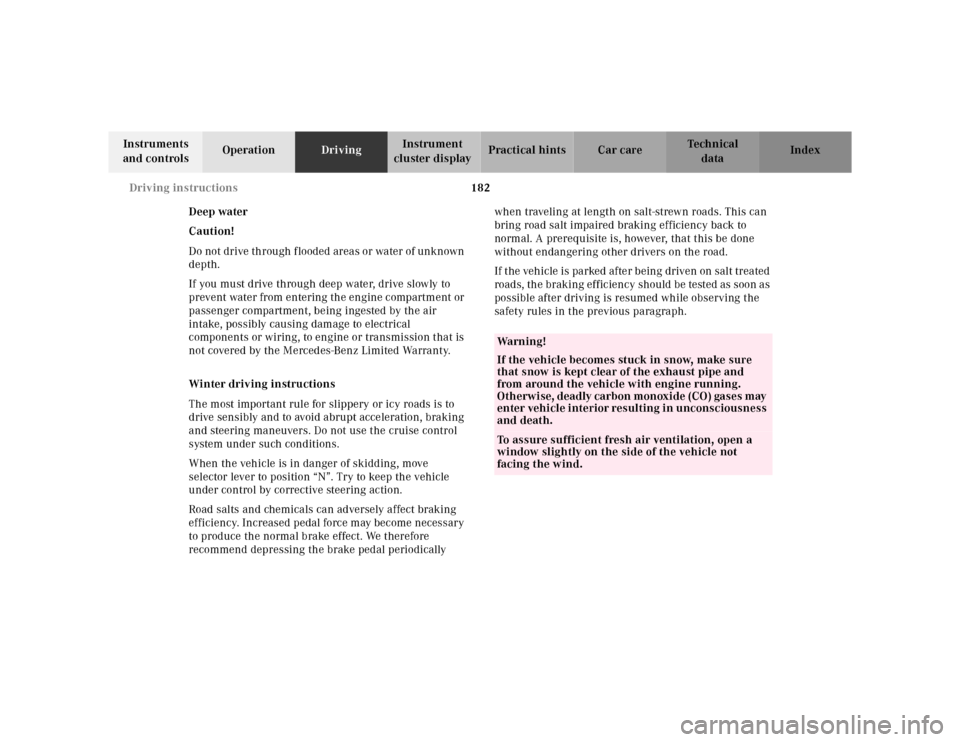
182 Driving instructions
Te ch n ica l
data Instruments
and controlsOperationDrivingInstrument
cluster displayPractical hints Car care Index
Deep water
Caution!
Do not drive through flooded areas or water of unknown
depth.
If you must drive through deep water, drive slowly to
prevent water from entering the engine compartment or
passenger compartment, being ingested by the air
intake, possibly causing damage to electrical
components or wiring, to engine or transmission that is
not covered by the Mercedes-Benz Limited Warranty.
Winter driving instructions
The most important rule for slippery or icy roads is to
drive sensibly and to avoid abrupt acceleration, braking
and steering maneuvers. Do not use the cruise control
system under such conditions.
When the vehicle is in danger of skidding, move
selector lever to position “N”. Try to keep the vehicle
under control by corrective steering action.
Road salts and chemicals can adversely affect braking
efficiency. Increased pedal force may become necessary
to produce the normal brake effect. We therefore
recommend depressing the brake pedal periodically when traveling at length on salt-strewn roads. This can
bring road salt impaired braking efficiency back to
normal. A prerequisite is, however, that this be done
without endangering other drivers on the road.
If the vehicle is parked after being driven on salt treated
roads, the braking efficiency should be tested as soon as
possible after driving is resumed while observing the
safety rules in the previous paragraph.
Wa r n i n g !
If the vehicle becomes stuck in snow, make sure
that snow is kept clear of the exhaust pipe and
from around the vehicle with engine running.
Otherwise, deadly carbon monoxide (CO) gases may
enter vehicle interior resulting in unconsciousness
and death.To assure sufficient fresh air ventilation, open a
window slightly on the side of the vehicle not
facing the wind.
Page 241 of 302
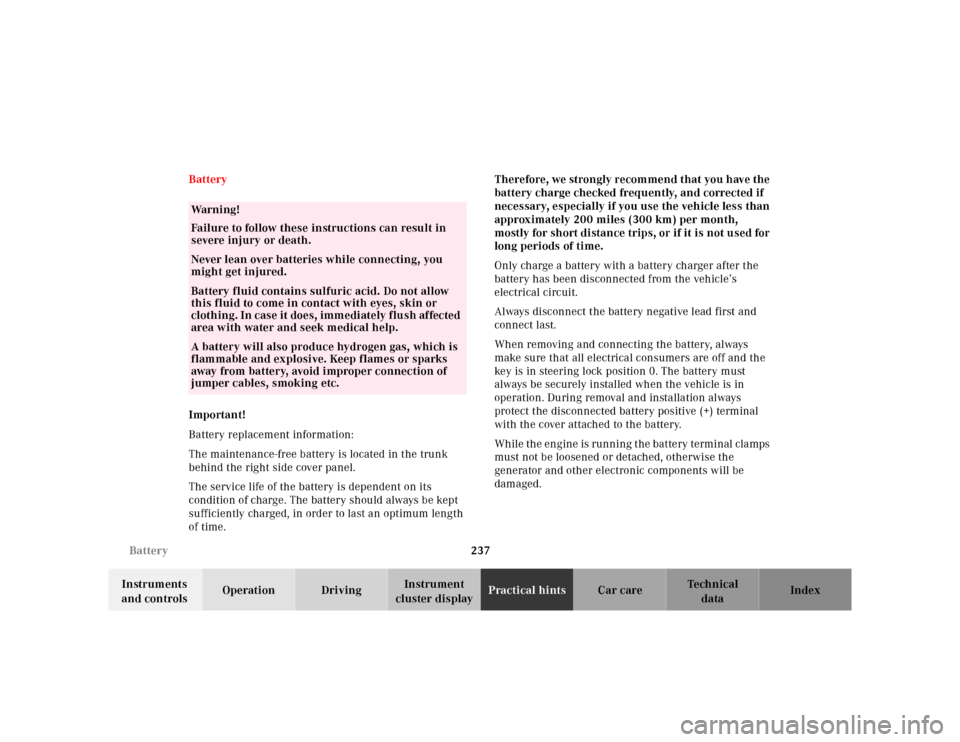
237 Battery
Te ch n ica l
data Instruments
and controlsOperation DrivingInstrument
cluster displayPractical hintsCar care Index Battery
Important!
Battery replacement information:
The maintenance-free battery is located in the trunk
behind the right side cover panel.
The service life of the battery is dependent on its
condition of charge. The battery should always be kept
sufficiently charged, in order to last an optimum length
of time.Therefore, we strongly recommend that you have the
battery charge checked frequently, and corrected if
necessary, especially if you use the vehicle less than
approximately 200 miles (300 km) per month,
mostly for short distance trips, or if it is not used for
long periods of time.
Only charge a battery with a battery charger after the
battery has been disconnected from the vehicle’s
electrical circuit.
Always disconnect the battery negative lead first and
connect last.
When removing and connecting the battery, always
make sure that all electrical consumers are off and the
key is in steering lock position 0. The battery must
always be securely installed when the vehicle is in
operation. During removal and installation always
protect the disconnected battery positive (+) terminal
with the cover attached to the battery.
While the engine is running the battery terminal clamps
must not be loosened or detached, otherwise the
generator and other electronic components will be
damaged.
Wa r n i n g !
Failure to follow these instructions can result in
severe injury or death.Never lean over batteries while connecting, you
might get injured.Battery fluid contains sulfuric acid. Do not allow
this fluid to come in contact with eyes, skin or
clothing. In case it does, immediately flush affected
area with water and seek medical help.A battery will also produce hydrogen gas, which is
flammable and explosive. Keep flames or sparks
away from battery, avoid improper connection of
jumper cables, smoking etc.
Page 243 of 302
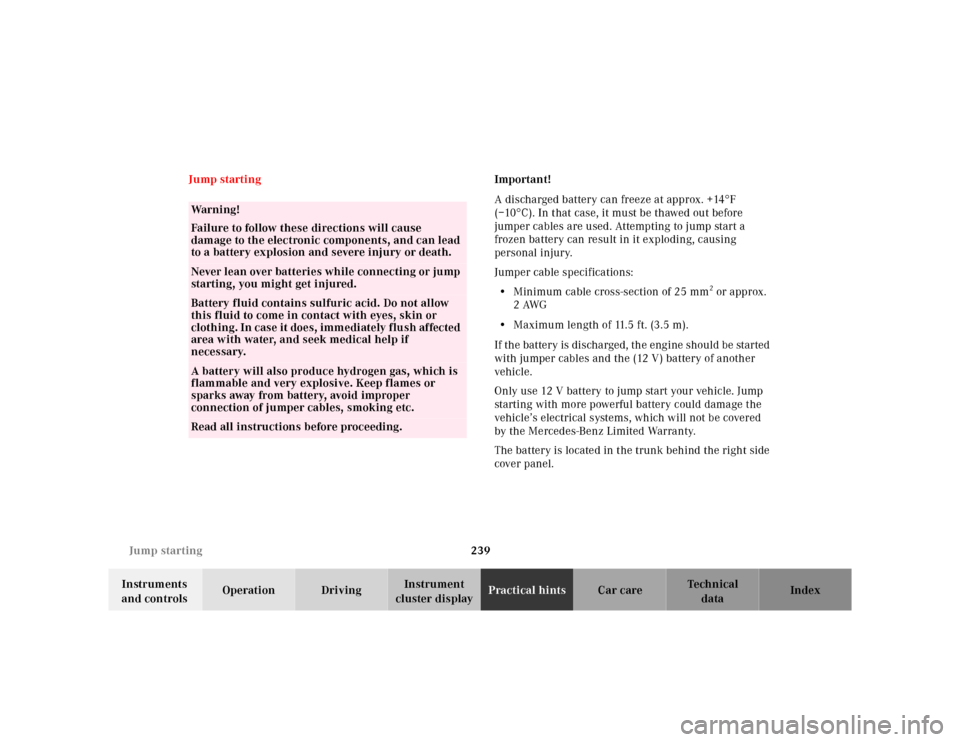
239 Jump starting
Te ch n ica l
data Instruments
and controlsOperation DrivingInstrument
cluster displayPractical hintsCar care Index Jump startingImportant!
A discharged battery can freeze at approx. +14°F
(–10°C). In that case, it must be thawed out before
jumper cables are used. Attempting to jump start a
frozen battery can result in it exploding, causing
personal injury.
Jumper cable specifications:
• Minimum cable cross-section of 25 mm
2 or approx.
2AWG
• Maximum length of 11.5 ft. (3.5 m).
If the battery is discharged, the engine should be started
with jumper cables and the (12 V) battery of another
vehicle.
Only use 12 V battery to jump start your vehicle. Jump
starting with more powerful battery could damage the
vehicle’s electrical systems, which will not be covered
by the Mercedes-Benz Limited Warranty.
The battery is located in the trunk behind the right side
cover panel.
Wa r n i n g !
Failure to follow these directions will cause
damage to the electronic components, and can lead
to a battery explosion and severe injury or death.Never lean over batteries while connecting or jump
starting, you might get injured.Battery fluid contains sulfuric acid. Do not allow
this fluid to come in contact with eyes, skin or
clothing. In case it does, immediately flush affected
area with water, and seek medical help if
necessary.A battery will also produce hydrogen gas, which is
flammable and very explosive. Keep flames or
sparks away from battery, avoid improper
connection of jumper cables, smoking etc.Read all instructions before proceeding.
Page 270 of 302
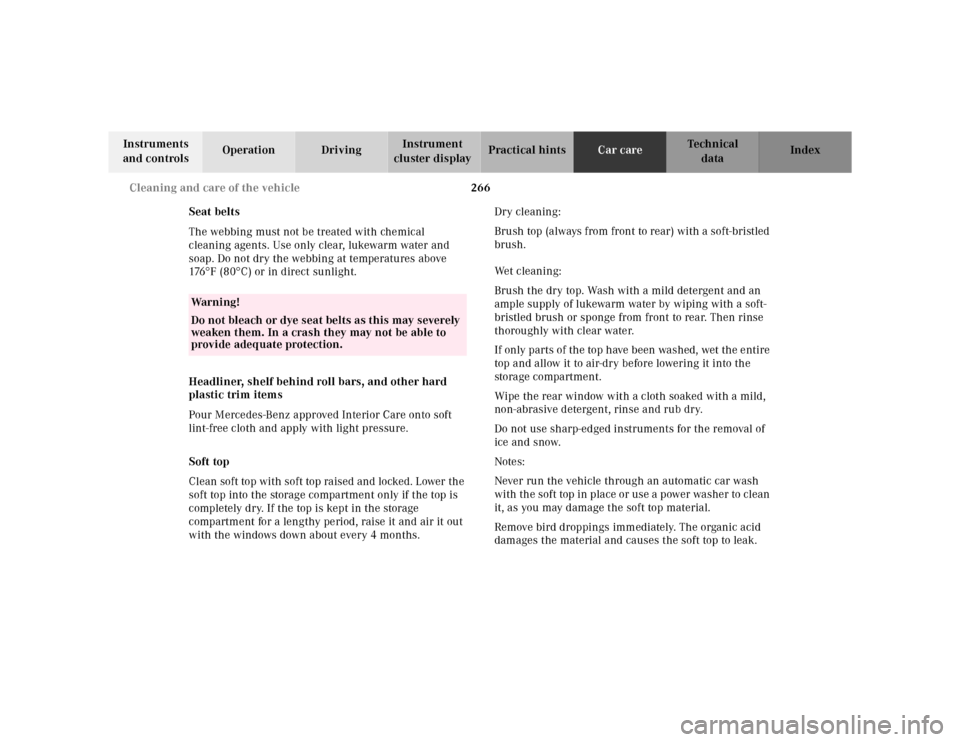
266 Cleaning and care of the vehicle
Te ch n ica l
data Instruments
and controlsOperation DrivingInstrument
cluster displayPractical hintsCar careIndex
Seat belts
The webbing must not be treated with chemical
cleaning agents. Use only clear, lukewarm water and
soap. Do not dry the webbing at temperatures above
176°F (80°C) or in direct sunlight.
Headliner, shelf behind roll bars, and other hard
plastic trim items
Pour Mercedes-Benz approved Interior Care onto soft
lint-free cloth and apply with light pressure.
Soft top
Clean soft top with soft top raised and locked. Lower the
soft top into the storage compartment only if the top is
completely dry. If the top is kept in the storage
compartment for a lengthy period, raise it and air it out
with the windows down about every 4 months. Dry cleaning:
Brush top (always from front to rear) with a soft-bristled
brush.
Wet cleaning:
Brush the dry top. Wash with a mild detergent and an
ample supply of lukewarm water by wiping with a soft-
bristled brush or sponge from front to rear. Then rinse
thoroughly with clear water.
If only parts of the top have been washed, wet the entire
top and allow it to air-dry before lowering it into the
storage compartment.
Wipe the rear window with a cloth soaked with a mild,
non-abrasive detergent, rinse and rub dry.
Do not use sharp-edged instruments for the removal of
ice and snow.
Notes:
Never run the vehicle through an automatic car wash
with the soft top in place or use a power washer to clean
it, as you may damage the soft top material.
Remove bird droppings immediately. The organic acid
damages the material and causes the soft top to leak.
Wa r n i n g !
Do not bleach or dye seat belts as this may severely
weaken them. In a crash they may not be able to
provide adequate protection.
Page 277 of 302

273 Technical data
Te ch n ica l
data Instruments
and controlsOperation DrivingInstrument
cluster displayPractical hints Car care Index Technical data
Model SL 500 (129.068)
1
SL 600 (129.076)
1
Engine113 1 2 0
Mode of operation 4-stroke engine,
gasoline injection4-stroke engine,
gasoline injection
No. of cylinders 8 12
Bore 3.82 in (97.00 mm) 3.50 in (89.00 mm)
Stroke 3.30 in (84.00 mm) 3.16 in (80.20 mm)
Total piston displacement 303 cu.in. (4966 cm
3) 365.4 cu.in. (5987 cm
3)
Compression ratio 8.8:1 10:1
Output acc.
to SAE J 1349302 hp/5600 rpm
(225 kW/5600 rpm)389 hp/5200 rpm
(290 kW/5200 rpm)
Maximum torque acc.
to SAE J 1349339ft.lb/2750 rpm
(460 Nm/2750 rpm)420ft.lb/3800 rpm
(570 Nm/3800 rpm)
Maximum engine speed 6000 rpm 6000 rpm
Firing order 1-5-4-2-6-3-7-8 1-12-5-8-3-10-6-7-2-11-4-9
Poly-V-belts length 2390 mm 2585 mm
1 The quoted data apply only to the standard vehicle. See an authorized Mercedes-Benz Center for the corresponding data of all special bodies
and special equipment.
Page 280 of 302
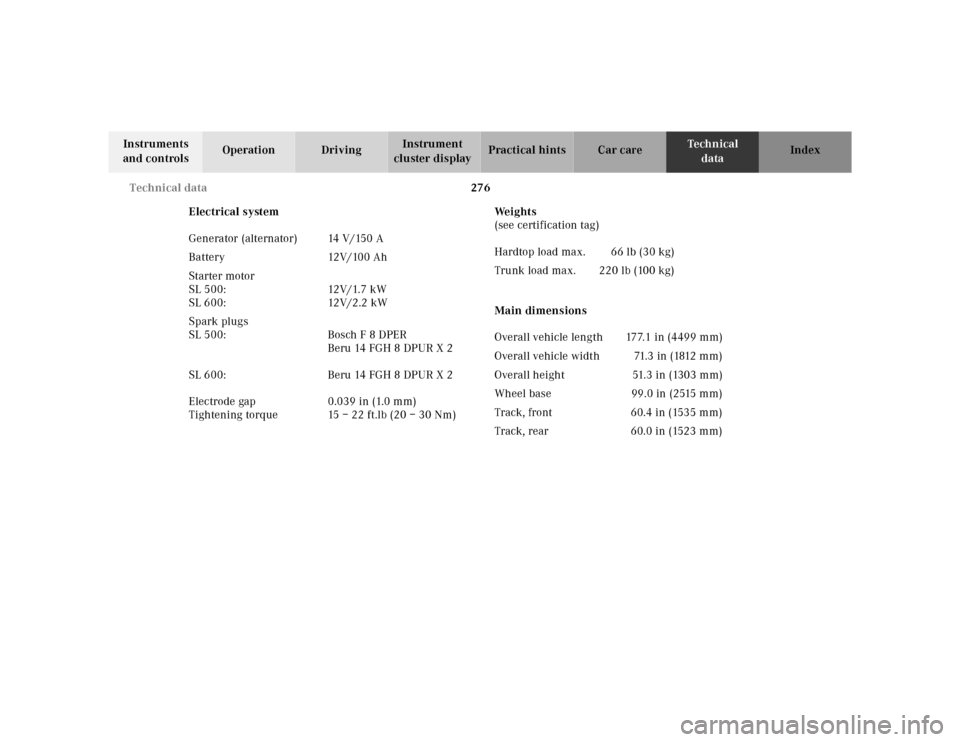
276 Technical data
Te ch n ica l
data Instruments
and controlsOperation DrivingInstrument
cluster displayPractical hints Car care Index
Electrical system Weights
(see certification tag)
Main dimensions Generator (alternator) 14 V/150 A
Battery 12V/100 Ah
Starter motor
SL 500:
SL 600:12 V / 1. 7 k W
12V/2.2 kW
Spark plugs
SL 500:
SL 600:
Electrode gap
Tightening torqueBosch F 8 DPER
Beru 14 FGH 8 DPUR X 2
Beru 14 FGH 8 DPUR X 2
0.039 in (1.0 mm)
15 – 22 ft.lb (20 – 30 Nm)Hardtop load max. 66 lb (30 kg)
Trunk load max. 220 lb (100 kg)
Overall vehicle length 177.1 in (4499 mm)
O ve r a l l v e h i c l e w i d t h 71.3 in ( 1812 m m )
Overall height 51.3 in (1303 mm)
Wheel base 99.0 in (2515 mm)
Track, front 60.4 in (1535 mm)
Track, rear 60.0 in (1523 mm)